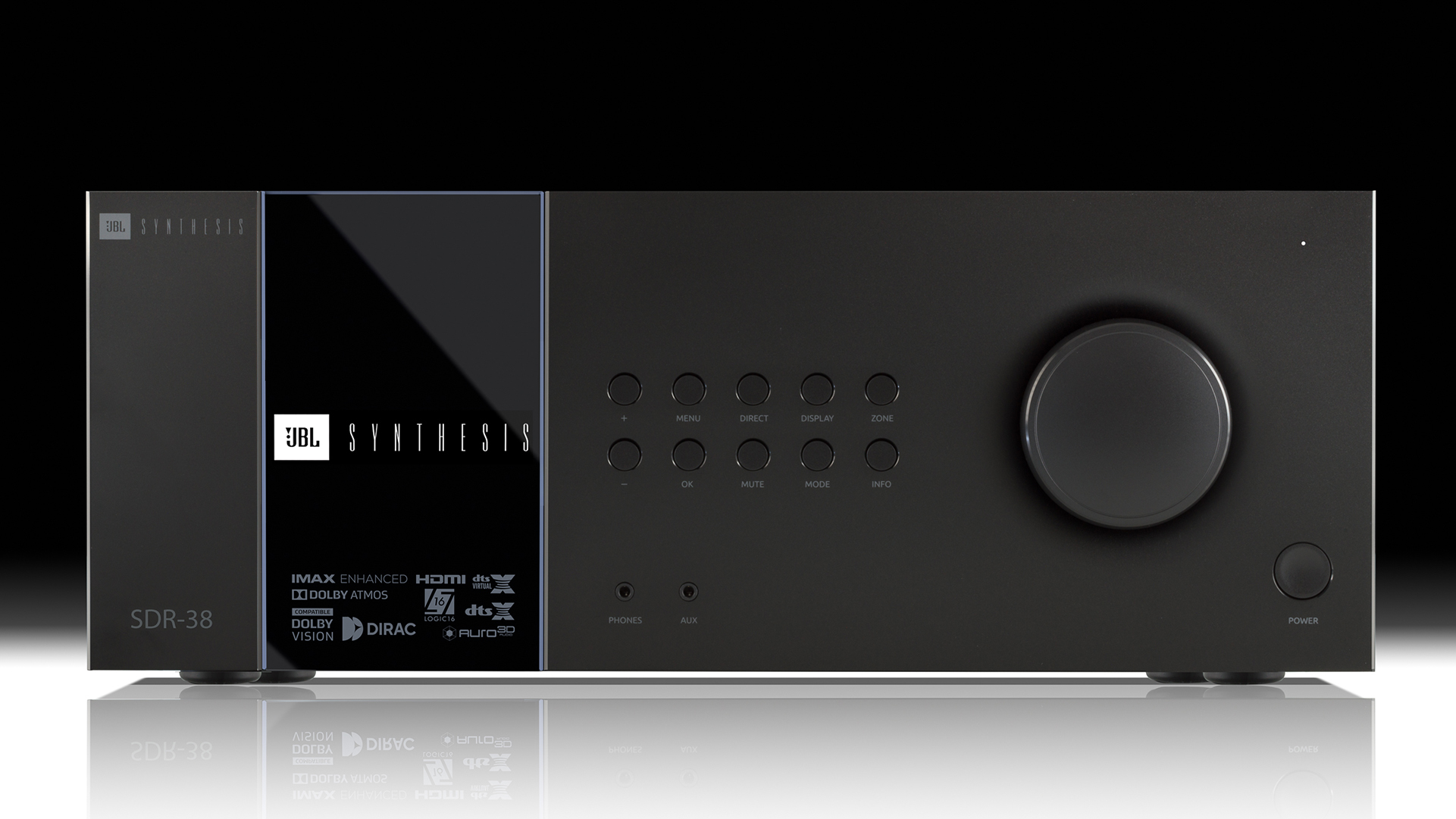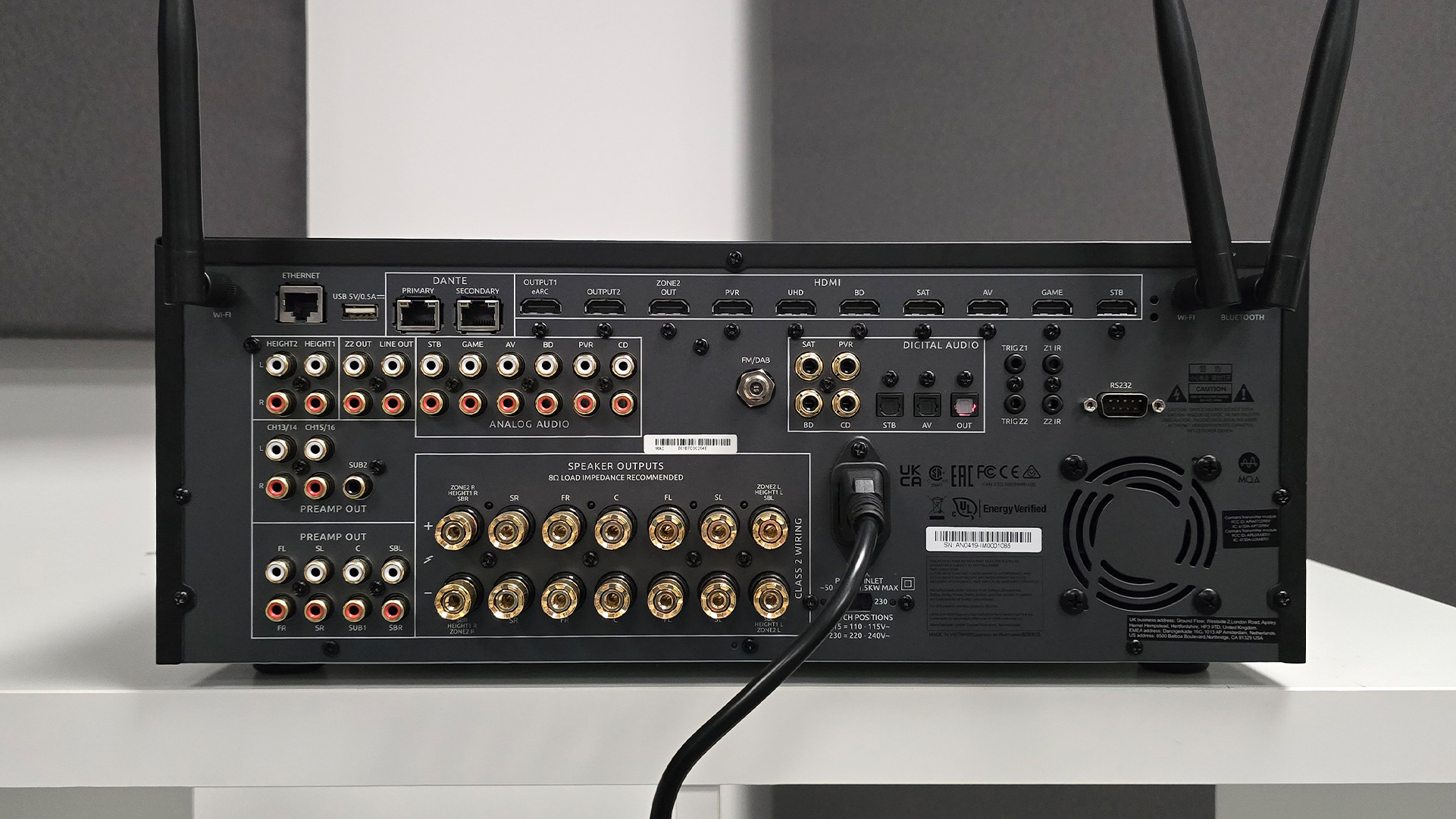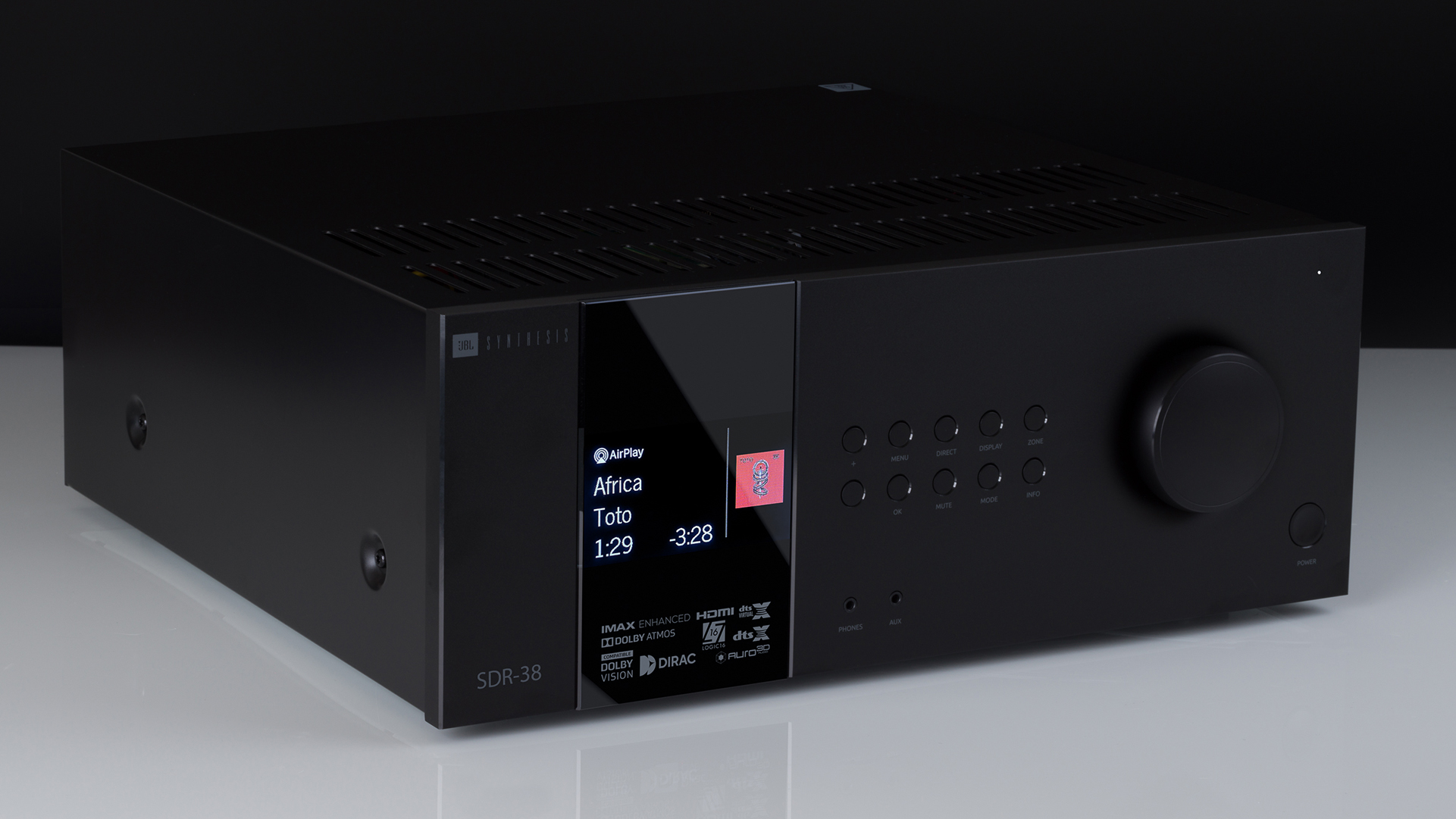What Hi-Fi? Verdict
Despite a steep price increase, it’s hard to argue with this JBL’s outstanding sonic performance, stylish build and extensive feature set
Pros
- +
Weighty and responsive low-end
- +
Wonderfully clear and detailed sound
- +
Excellent feature set with HDMI 2.1
Cons
- -
Only seven channels of power amplification
- -
Substantial price increase
Why you can trust What Hi-Fi?
No, you’re not having a severe episode of déjà vu – this is a new AVR from JBL that just so happens to look exactly like its predecessor. The Synthesis SDR-38 is a follow-up to the magnificent (and Award-winning) SDR-35 home cinema amplifier, complete with a handful of meaningful, but admittedly limited, updates.
In fact, JBL has hinted to us that this is practically the same AVR, just with a new HDMI board, meaning it should sound the same. Of course, we’ll be the judge of that.
Price

However, one thing that hasn’t remained from last year is the price. A steep increase for a board upgrade isn’t something we’re often receptive to and, at £7300 / $8550 / AU$16,999, it really is a lot more expensive than the model it’s replacing, which we reviewed at £6000 / $7500 / AU$15,000.
The spending doesn’t end there unfortunately, as if you’d like to hook up surround back speakers and Dolby Atmos channels at the same time, you’ll have to invest in an additional power amplifier. JBL makes a companion to this amplifier in the form of the Synthesis SDA-7120 AV Power Amplifier, although that retails for £3800 / $3849 / AU$8999, and so would take the total price of the set-up to £11,100 / $12,399 / AU$25,998.
The Arcam AVR31 which, along with the outgoing SDR-35, we’re using as our reference for sonic performance, was initially priced at £5799 / $5250 / AU$11,495; although that’s recently dropped to £5499 in the UK. Arcam and JBL are sister brands and, in truth, these two amplifiers are uncannily similar.
Build

Speaking of uncannily similar, the Synthesis SDR-38 is visually almost identical to the SDR-35 it replaces. We have them side by side, and we can honestly say that if it weren’t for the name being printed on the front of each device, we’d have no idea which one was which.
Luckily, the SDR-35 was already one of the more eye-catching AVRs on the market, and so the SDR-38 continues that legacy. The matte gunmetal grey front panel is still a smart look, and it is contrasted nicely with the glossy section that houses the OLED display. You’ll also find a selection of on-device controls that can be used to adjust volume, switch to Direct Stereo and access the settings menu.
The latest hi-fi, home cinema and tech news, reviews, buying advice and deals, direct to your inbox.
Unfortunately, the settings menu only shows in full on the small display on the unit itself, with no option for an on-screen setup for the connected TV or projector. This can be frustrating as we often find ourselves going back to tweak levels or rifle through settings to check things for our review.
On the right-hand side of the unit, you’ll find a volume wheel that glides with a smooth rotating motion that feels appropriately premium. The build quality is certainly up to scratch, but at 18kg and 17 x 43 x 43cm (hwd), this is not a dainty unit by any means. Make sure you have a rack that can support this AVR, while giving it ample ventilation, and you might want to leave some space for that power amplifier depending on your speaker system.
Features

The SDR-38 features seven channels of Class G amplification, with up to 180W of power per channel with all seven channels driven. This can be used in either a 7.1 or 5.1.2 configuration, depending on whether you’d prefer two rear speakers or two Dolby Atmos height speakers. Alternatives from Denon and Pioneer offer 11 channels of amplification for less than half of the price.
The headlining feature on this new JBL is the upgrade to full bandwidth HDMI 2.1 spec on all seven of the HDMI inputs. These support up to 4K/120Hz from the latest gaming consoles, and even 8K/60Hz, should you ever end up with a device that outputs such a format. Elsewhere you’ll find two optical connectors and six stereo RCA connections. On the output front, you’ll find three HDMI sockets, one of which is designated as eARC, while the others are labelled as Output 2 and Zone 2; the latter being used for feeding a system in a second room if you don’t plan on using all amplification channels in one area.

HDMI inputs x 7
HDMI outputs x 3
ARC/eARC eARC
HDMI 2.1 features 4K/120Hz, 8K/60Hz, VRR, ALLM on all rear HDMI inputs
Amplification 7 channels
HDR formats HDR10, HDR10+, HLG, Dolby Vision
Audio formats Dolby Atmos, DTS:X, Auro-3D
Streaming AirPlay 2, Spotify, Chromecast Built In, Tidal, Roon Ready, Bluetooth
Voice assistant? No
The JBL also boasts a comprehensive set of wireless connectivity features, with hi-res and MQA support via Roon, as well as Spotify Connect, Tidal Connect, Google Chromecast, Apple AirPlay 2 and Bluetooth with the aptX HD codec supported.
Moving on from connectivity, the JBL supports all of the video and audio formats we’d expect from an amplifier at this price. That includes HDR in the HDR10, HDR10+, Dolby Vision and HLG formats, as well as Dolby Atmos, DTS:X, Auro 3D and IMAX Enhanced on the audio format side.
There also some pro-oriented features for those who want to get stuck into them, such as Dirac Live room calibration – JBL kindly includes the necessary microphone for this. This is a much more involved process that requires additional computer software to set up; unlike other AVRs from the likes of Denon, Pioneer and Sony that feature fully automated set-ups by including a microphone that attaches directly to the amp. In our experience, the results from Dirac Live can be convincing but need to be done by an experienced user (the selling dealer, ideally) to get optimal results.
As was the case with the SDR-35, the SDR-38 also features Logic 16 processing, which is used to create a more convincing 3D soundscape. This process can upmix all signals, including mono, to 15.1 channels.
Finally, we make our way to the remote. It’s practically identical to both the SDR-35’s remote and that of the Arcam AVR31, which is no issue for us. The remote’s backlight kicks in at the press of a button, making it an ideal accessory for our dark home cinema testing room, and we can’t spot any shortcomings when it comes to the selection of buttons.
Sound

JBL assures us that this AVR sounds practically the same as the unit it's replacing, and that's more or less true, although we have identified one difference between these two home cinema amplifiers. For today’s testing, we’ve paired the JBL with our reference speaker system – the PMC Twenty5.23 home cinema package – in a 7.1 surround arrangement.
Starting with Dune in Dolby Atmos, we opt for the scene in which the Atreides clan ventures out in an Ornithopter to scope out the spice fields of Arrakis. Immediately we are struck by the clarity and spatial effect that this AVR produces, as evidenced by the conversation between Dr Liet Kynes and the members of House Atreides. The spacious, echoey environment of the aircraft hangar is reproduced with a grand and expansive sense of scale, while the conversation that takes place regarding the Stillsuits is packed with a tangible low-level dynamic flair that incorporates warmth, subtlety and (most importantly) character to each voice.
As the scene transitions to the titular dunes of the desert planet, we identify a key difference between this AVR and its predecessor. Despite being set up in exactly the same way (regarding speaker distances and levels), the newer JBL features a little extra bass oomph, allowing for a slightly more guttural and dynamic low-end. This is evident with the thunderous drum ensemble that accompanies the scene, which is delivered with a touch more punch and weight on the newer JBL. This helps to build tension in the worm attack scene, adding a greater sense of impact.
Switching to The Batman’s excellent car chase scene, we’re reminded of the best qualities from the previous Award-winning iteration of this home cinema amplifier. Everything from the cascade of bullets that The Penguin unleashes onto the car that he thinks Catwoman is hiding behind, to the snarl of the Batmobile’s engine, is delivered with excellent detail and clarity. The SDR-38 is wonderfully revealing, digging out all of the finer details we’d hope to hear from an AVR of this stature, making it well-suited to our reference speaker system.
Michael Giacchino’s formidable score kicks into life with vigour, as the dynamic punch of the brass section elicits goosebumps, handled masterfully by the JBL in this instance. As the car chase tears along the Gotham motorway, we experience an immersive surround spectacle, as the titular hero weaves between cars and lorries. The surround effect is solid throughout all channels, leaving no obvious gaps between each speaker, while simultaneously ensuring that no speaker sticks out disproportionately.
Rounding out our film test with something slightly quieter, we switch to Interstellar, specifically the scene in which the team discovers Mann and awakens him from cryosleep. Here we can decipher how the JBL handles quieter and more emotive moments, as the team discusses the possibility of bringing humanity to the frozen planet. The earnest nature of the discussion is delivered with gravitas and a sprinkle of optimism and hope through the subtleties within the characters’ delivery.
The SDR-38 transfers its sonic talents to music playback well. We described its predecessor as “about as hi-fi as home cinema products get”, and that's a statement we’re more than willing to repeat for this latest model. Switching to stereo for Taylor Swift’s Ivy, we’re rewarded with rhythmic precision and a rich vocal presentation, with plenty of detail to be found in the intricate string section that underpins the track.
The big question is: does this JBL outperform its Arcam counterpart? The answer is yes, but the differences certainly aren’t night and day. The JBL is a touch more powerful, and it shows with the enhanced dynamic control and punchier low end. If you’re looking for value for money, we certainly wouldn’t blame you for opting for the Arcam, but where performance is concerned, the JBL is the better amplifier.
Verdict

JBL’s latest flagship AVR is a costly spec bump, but we can’t deny how good it sounds. The Synthesis SDR-38 is a home cinema amplifier for those who want to take home cinema audio seriously, and its performance proves that.
That being said, we’re not thrilled by the fact that HDMI 2.1 compatibility has been added this late and at such a premium, and the existence of the Arcam AVR31 is a thorn in the JBL’s side. Nonetheless, the SDR-38 is a mighty fine-sounding home cinema amplifier, with undeniably impressive sonic chops.
SCORES
- Sound 5
- Features 4
- Build 4
MORE:
Read our review of the Arcam AVR31
Also consider the Denon AVC-X6700H
Read our Yamaha RX-A6A review
Best AV receivers: the top home cinema amplifiers we've tested
What Hi-Fi?, founded in 1976, is the world's leading independent guide to buying and owning hi-fi and home entertainment products. Our comprehensive tests help you buy the very best for your money, with our advice sections giving you step-by-step information on how to get even more from your music and movies. Everything is tested by our dedicated team of in-house reviewers in our custom-built test rooms in London, Reading and Bath. Our coveted five-star rating and Awards are recognised all over the world as the ultimate seal of approval, so you can buy with absolute confidence.


